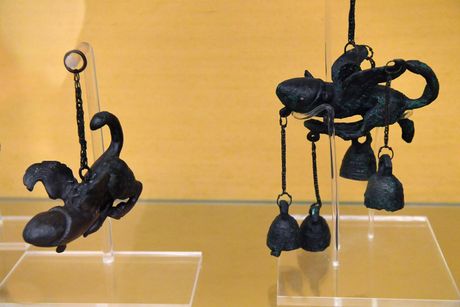Ancient bizarrely-shaped tintinnabulum protected Romans from evil: World discovery at Serbia's Viminacium site
A team of researchers found a unique object - a tintinnabulum, a kind of wind chime meant to guard a home, dating back to the time of the Roman Empire in these areas. The discovery was made in the archaeological park Viminacium, eastern Serbia.
This object has unusual shape - that of a winged phallus - and served to protect against evil forces and the evil eye.
The moment of this discovery was presented in a video posted by the Archaeological Institute of the Serbian Academy of Sciences and Arts (SANU) on its Instagram page.
"We present to you the moment of the discovery of the tintinabulum which once again placed Viminacium among the most important sites in the territory of the Roman Empire," the video's description states.
It is added that this is a sensational find.
"Tintinnabulums are the ancient counterpart of today's wind chimes. They were hanging in front of the front door or a room to disperse evil forces and the evil eye," the video states.
Speaking on Radio-Television of Serbia (RTS) Dr. Miomir Korac, director of the Archaeological Institute, said that this unique object had the function of a bell, but also a kind of "house guard."
"We knew that the Romans were superstitious. It was simply their way of life and they felt they had to defend themselves against evil spirits. When you discover something like this, it is world class, simply because it is quite rare. Overall, a museum in Naples and the British Museums have something like it," he told RTS.
Archaeologist Catherine Jones also wrote about tintinnabulums in the book, "Sex or Symbol: Erotic Images of Greece and Rome."

"The use of the (shape of) phallus as protection on buildings developed into a decorative form that went beyond simple carvings on walls. Objects made of bronze, with bells, hung in the courtyards of a home, where the wind could move them and create sound. The bells themselves helped to dispel evil, it was believed, and this effect was thought to increase the power of the motive.
Over time, these objects known as tintinnabulums very often assumed a phallic shape. Examples are known to us from many sites, and the best preserved examples are those from Pompeii. It is not known whether these forms represented a kind of fear of sexuality as an uncontrollable animal drive, or were simply fun for people. The addition of legs, arms or wings to phalluses represented several different concepts.
First, it transformed the phallus into a small independent animal that represented an organ that was less under the owner's control than desired. Second, the power of the phallus was enhanced by associations with deities. Many objects of this type were simply a source of entertainment for the owner," she explained.
(Telegraf.rs)
Video: Premijera dokumentarnog filma o grofu Savi Vladislaviću Raguzinskom
Telegraf.rs zadržava sva prava nad sadržajem. Za preuzimanje sadržaja pogledajte uputstva na stranici Uslovi korišćenja.

